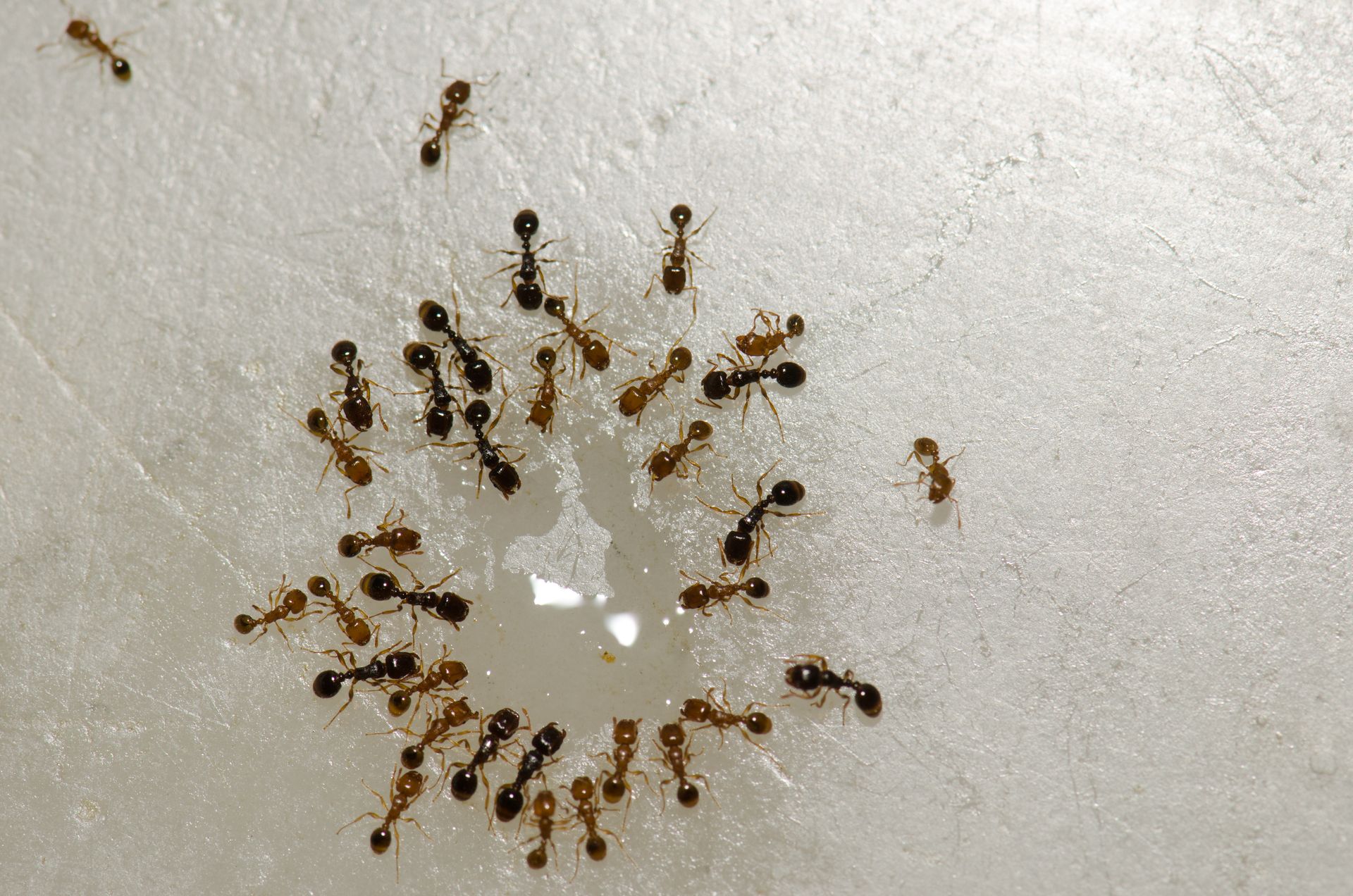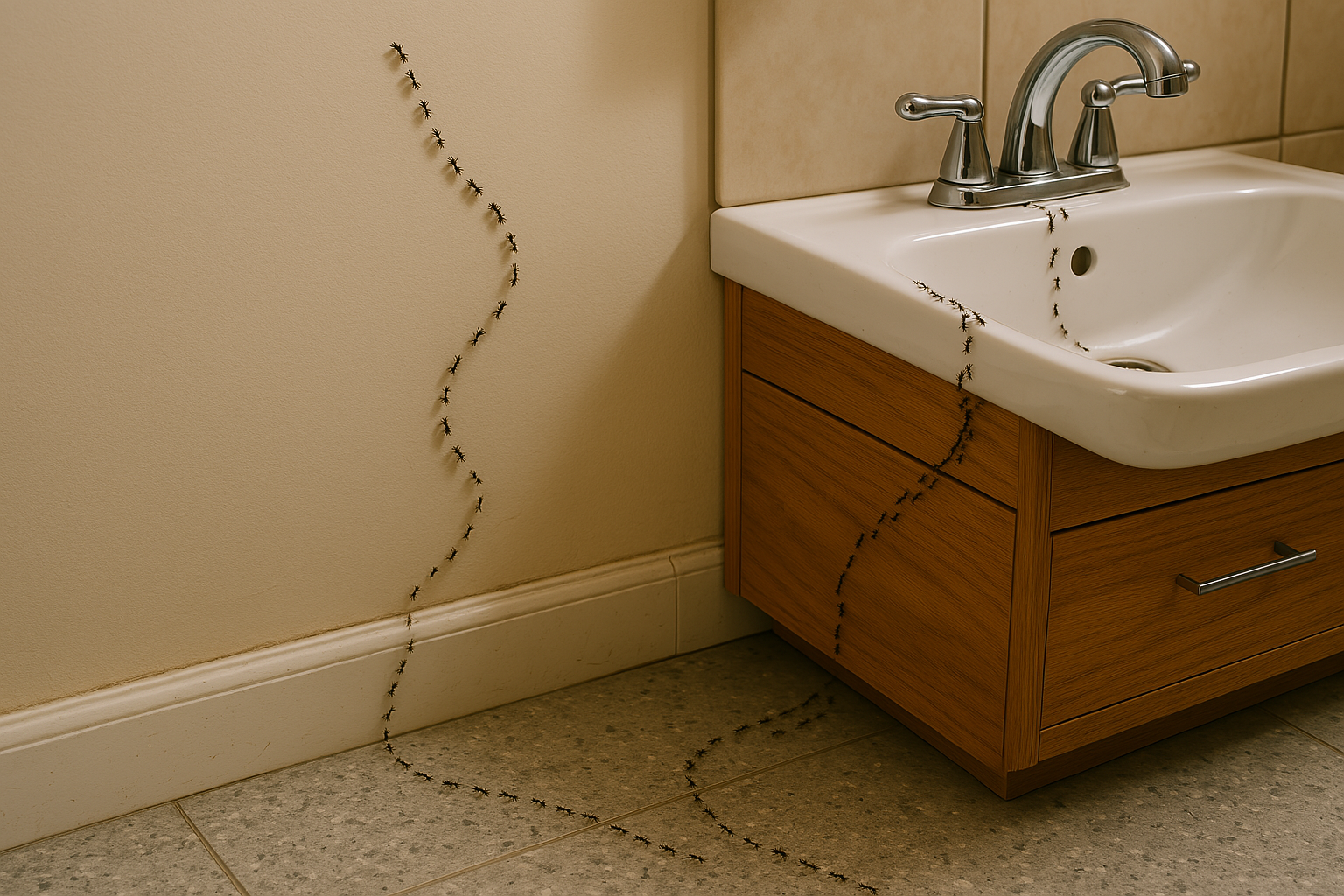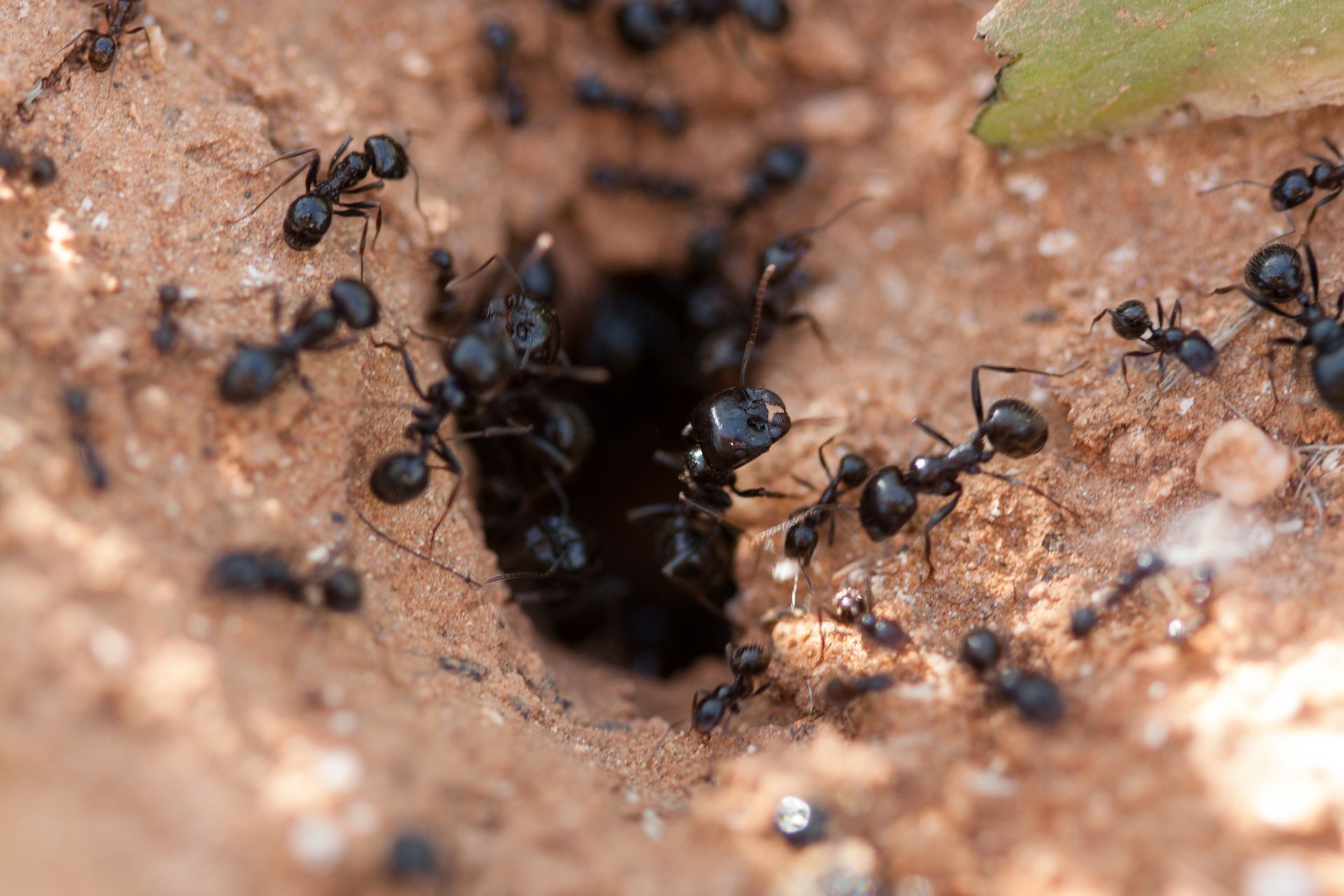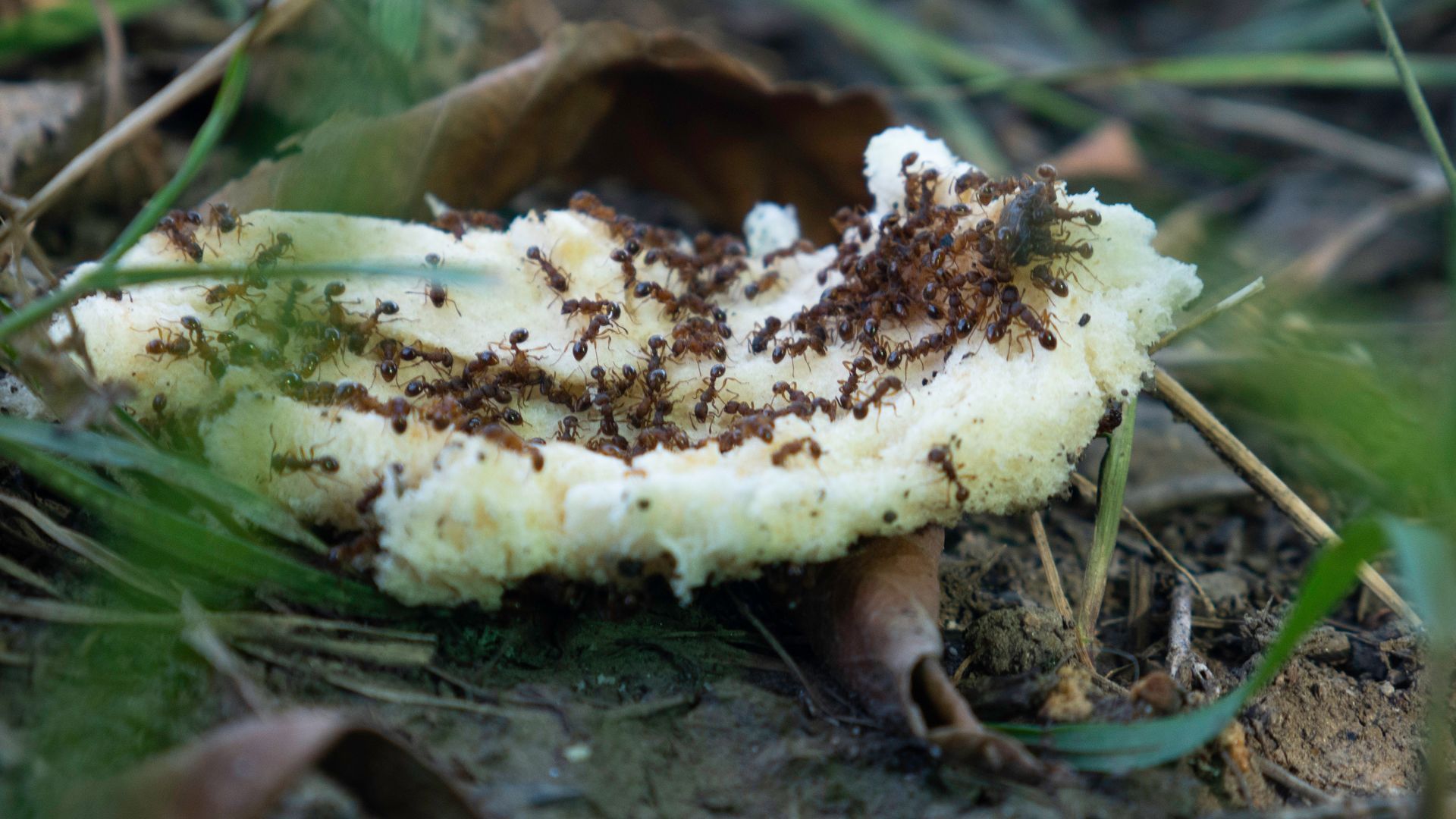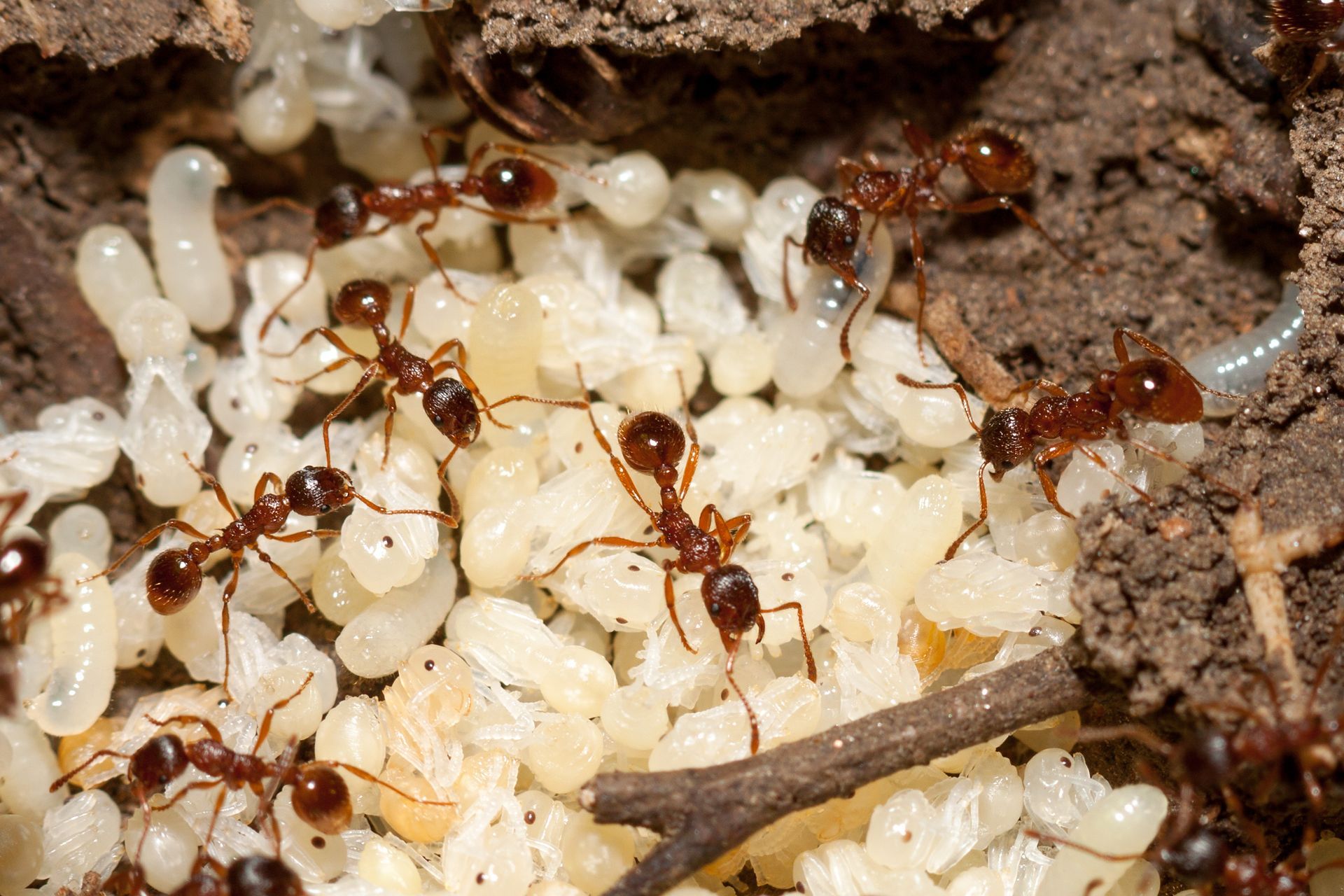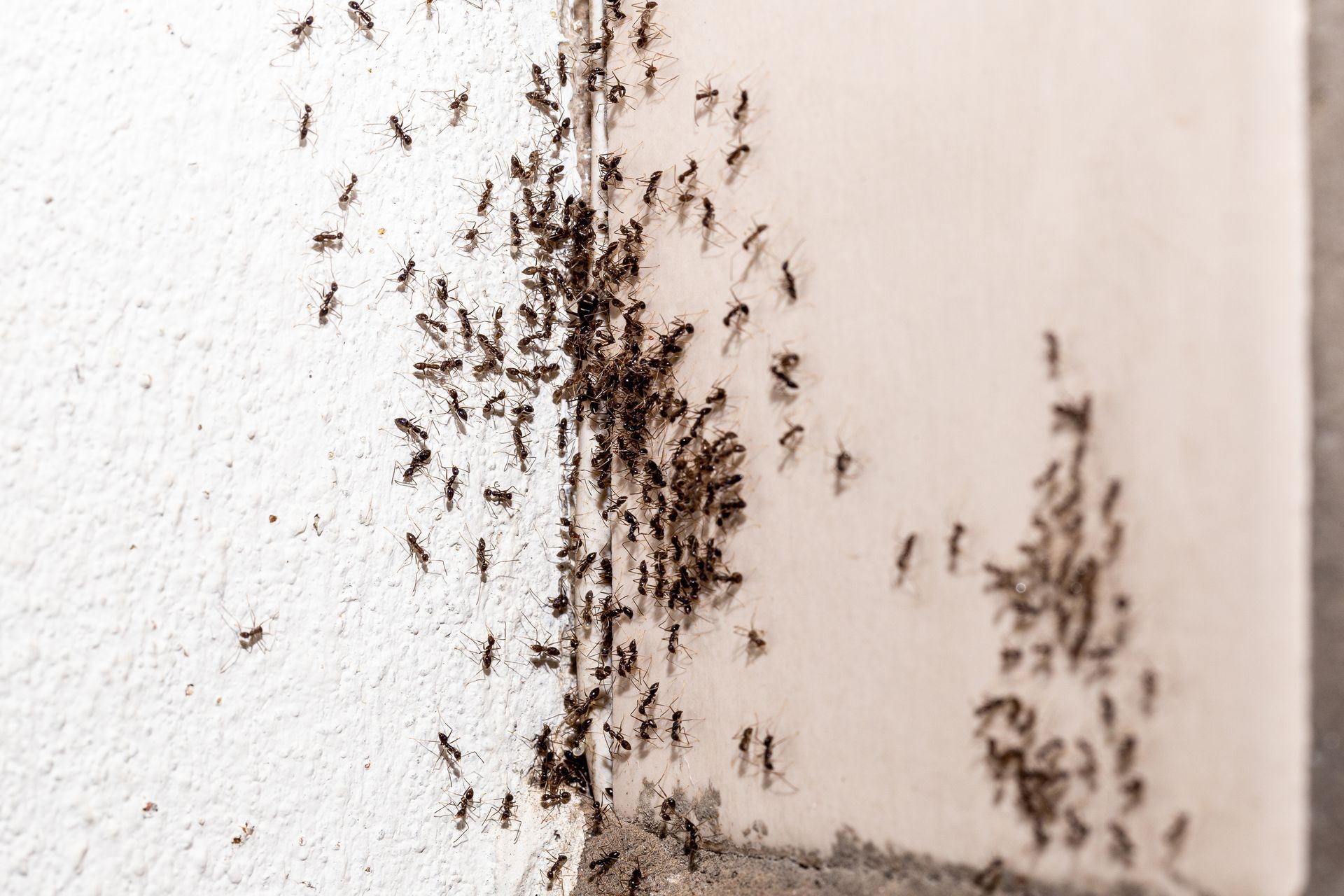Professional Fire Ant Control & Treatments
Fire ants are tiny insects with a burning sting. They transform outdoor spaces from peaceful retreats into painful no go zones. These aggressive invaders establish massive underground networks while their mounds disrupt landscapes and their venom sends thousands to emergency rooms annually. Whether your property hosts a few isolated mounds or faces a full scale invasion, EcoGuard's specialized fire ant management programs eliminate existing colonies while creating long term protection against these territorial pests.
Call today to a free estimate. 866-326-2847
Pest FREE Guarantee
All Natural Services
Licensed & Insured
Competitive Pricing
Fire Ant Control Experts
Successful fire ant management demands specialized knowledge of their complex colony structures, reproductive patterns, and territorial behaviors. Our certified fire ant exterminators undergo extensive training in fire ant biology, focusing on their unique multi queen systems and underground network architecture. This expertise enables our team to implement strategic approaches that target entire colonies, including hidden queens, rather than simply treating visible mounds which help ensure complete elimination rather than temporary surface control.
Why Fire Ant Are a Serious Problem
These aggressive invaders create multiple challenges demanding professional attention:
- Fire ants deliver painful, burning stings containing alkaloid venom that creates distinctive pustules and potential life threatening reactions in sensitive individuals. A single disturbed mound can release thousands of ants that aggressively attack in coordinated waves, each ant capable of stinging repeatedly, creating serious health risks particularly for children, elderly, and pets.
- Unlike native ant species, red imported fire ants establish colonies with multiple queens, each capable of laying up to 1,500 eggs daily which allows colonies to expand exponentially and split into new territories. This reproductive efficiency enables rapid spread across properties while making elimination extremely difficult as colonies can quickly recover if even a few queens survive treatment.
- These destructive pests damage electrical equipment, irrigation systems, and HVAC units by building nests inside housings and chewing through insulation. Their excavation activities undermine structural foundations, pavements, and pool areas while creating unsafe conditions and expensive repair needs throughout landscaped areas.
- Fire ant colonies construct extensive underground tunnel networks extending 1-5 feet deep and up to 25 feet horizontally from visible mounds, creating widespread subsurface infestations invisible to property owners. Their aggressive displacement of native insects disrupts local ecosystems while creating agricultural losses estimated at over $6 billion annually across the United States.
Fire Ant Treatments Options
EcoGuard is a leader in fire ant control methodology and service.
Our comprehensive approach to fire ant pest control combines multiple professional grade strategies designed for complete colony elimination:
- Individual Mound Drenching: Powerful liquid applications penetrate mound structures, saturating tunnels and chambers to reach queens and developing brood deep within underground colony networks.
- Growth Regulator Broadcast Treatments: Advanced insect growth regulators applied across entire properties, preventing queen reproduction and disrupting fire ant development cycles for long term population control.
- Strategic Baiting Programs: Professional grade granular baits strategically placed where foraging ants gather food, utilizing their own workers to carry control agents directly to queens and larvae hidden within colonies.
- Barrier Protection Applications: Creation of defensive perimeters using residual insecticides that maintain extended protection against new colony establishment and migration.
- Soil Incorporation Treatments: Deep reaching formulations mechanically incorporated into soil profiles, targeting underground tunnels and satellite colonies developing below the surface.
- Repellent Systems: Specialized deterrent applications creating zones that fire ants actively avoid, particularly effective around sensitive areas like gardens, play equipment, and pet spaces.
What Causes Fire Ant Problems?
Understanding the factors that support fire ant populations helps prevent infestations:
- Disturbed Soil: Recently landscaped areas, construction sites, and soil disturbances create ideal conditions for new colony establishment, as fire ants prefer areas with minimal competing ant populations and freshly exposed soil for new mounds.
- Open Sunny Areas: Fire ants thrive in open, sunny landscapes with minimal shade, particularly favoring lawn areas, pastures, and fields where solar heating warms their colonies and accelerates development of eggs and larvae.
- Adequate Moisture: Properties with irrigation systems, water features, or moderate soil moisture support fire ant populations by providing necessary hydration without flooding colonies, making managed landscapes particularly vulnerable to infestation.
- Food Resources: Areas with abundant insects, seeds, and protein sources sustain growing fire ant colonies, with managed landscapes often providing ideal nutrition through landscape plantings, mulched areas, and outdoor human activity generating food debris.
Signs of a Fire Ant Infestation
Learn to identify these distinctive indicators of fire ant activity:
- Dome shaped mounds: These holes don’t have central openings and generally appear after rain. They are typically 2-24 inches in height and composed of loose, granular soil
- Aggressive ant emergence: When a nest is disturbed, reddish brown ants ranging from 1/8 to 1/4 inch in length will swarm to defend the colony
- Pustules and burning sensations: These on skin following unknowing contact with fire ant colonies or foraging trails
- Multiple interconnected colonies: These appear across properties, often concentrated in sunny, open areas with adequate soil moisture
- Worker ants: They follow defined trails between mounds and food sources, particularly active during morning and evening hours
- Soil disturbance: Found around foundations, plant roots, and landscape features as colonies expand underground tunnel systems
DIY vs Professional Fire Ant Treatment
Store shelves overflow with fire ant "solutions" promising quick results, yet homeowners fighting these resilient invaders often experience a frustrating cycle of temporary victories followed by aggressive resurgence. These retail products typically deliver a deceptive initial impact as they kill fire ant worker while leaving the colony's reproductive core intact beneath the surface. Without reaching the queens, who remain safely protected in deep underground chambers, colonies quickly recover and often splinter into multiple new mounds.
What truly separates expert fire ant management from DIY attempts is our colony centered strategy rather than surface level symptom treatment. EcoGuard's approach leverages advanced pheromone disrupting compounds, strategically timed applications that align with fire ant biological cycles, and property specific treatment mapping that targets hidden satellite colonies. By combining deep reaching soil treatments with scientific bait product formulations carried directly to queens by the ants themselves, we break the reproductive cycle while creating defensive zones that prevent neighboring colonies from migrating onto your property. The result isn't just disappearing mounds, it's comprehensive elimination of the complex underground networks where fire ant colonies truly thrive.
Commercial Fire Ant Control
EcoGuard Pest Management provides specialized fire ant management programs for businesses where these aggressive pests create significant liability concerns and operational disruptions. Our commercial services deliver comprehensive fire ant elimination while maintaining regulatory compliance and minimizing business interruption through customized treatment protocols.
We provide expert fire ant pest control solutions for:
- Educational Institutions
- Healthcare Facilities
- Golf Courses and Athletic Fields
- Hospitality Properties
- Apartments and HOAs
- Shopping Centers
- Manufacturing Facilities
- Agricultural Operations
- Public Parks and Recreation Areas
- Solar Farms and Utilities
For immediate service for all of your ant control concerns please call 866-326-2847 or complete this form.
Fire Ant Guarantee
We understand the persistent nature of fire ant infestations and back our control services with a comprehensive guarantee. If fire ants return to treated areas during your service period, our fire ant exterminators will promptly return to reassess and retreat at no additional cost. Our commitment extends beyond initial colony elimination to ensure lasting protection through ongoing monitoring and proactive maintenance against these aggressive invaders.
Pest Control Process
Inspection: Our technicians conduct thorough property examinations focusing on identifying active mounds, satellite colonies, and conducive conditions supporting fire ant populations. This comprehensive assessment documents colony distribution, determines queen density, and evaluates landscape features influencing fire ant pressure, creating the foundation for effective treatment strategies.
Treatment: Based on inspection findings, we implement targeted control measures using specially formulated products designed to penetrate fire ant colonies and eliminate queens. These applications combine immediate control with extended protection which are strategically deployed based on your property's specific fire ant pressure and landscape characteristics.
Exclusion: We create defensive barriers and implement habitat modifications that discourage new colony establishment while disrupting fire ant foraging patterns. These preventive measures include property perimeter treatments, soil management recommendations, and landscape adjustments that reduce fire ant attractiveness.
Ongoing Monitoring: Regular property assessments track treatment effectiveness while identifying any new fire ant activity before it develops into established colonies. This proactive monitoring ensures early intervention against migrating colonies while maintaining comprehensive protection throughout seasonal changes in fire ant behavior.
Seasonal Plan for Fire Ant Control
Spring: This is a critical control period as overwintered colonies become fully active and queens begin maximum egg production. Spring treatments focus on preventing colony expansion while eliminating mounds before they reach peak summer activity. We implement comprehensive broadcast applications combined with individual mound treatments to provide maximum colony disruption.
Summer: Peak fire ant season requires vigilant monitoring as colonies reach maximum size and activity levels. Summer treatments emphasize maintaining control barriers during intense foraging periods while addressing new mound development. Special attention focuses on irrigation zones and landscape edges where expanding colonies frequently establish.
Fall: Strategic treatment period focusing on eliminating colonies before winter dormancy begins. Fall applications target fire ants as they consolidate colonies and forage intensively, making them particularly receptive to fire ant baiting programs. We implement preventive perimeter treatments while applying extended release formulations to provide protection through winter months.
Winter: Though surface activity decreases, fire ant colonies remain active below ground in most regions. Winter treatments focus on long term suppression agents that continue working through dormancy periods. We conduct comprehensive property inspections identifying overwintering colonies requiring treatment before spring activity resumes.
Fire Ant Control FAQs
How can I identify fire ants versus other ant species on my property?
Fire ants are reddish brown to reddish black, varying in size from 1/8 to 1/4 inch, with distinctive mounds lacking a central opening unlike most native ant species. The definitive identification comes from their aggressive behavior when disturbed as fire ants swarm from the mound in large numbers, climb vertical surfaces rapidly, and deliver painful stings that develop into pustules within 24 hours.
Why are fire ant mounds appearing in my yard despite regular lawn maintenance?
Fire ants establish colonies regardless of landscape maintenance because their primary requirements which include adequate soil moisture, sunlight, and food resources remain available despite mowing and basic yard care. Regular maintenance may actually support fire ant populations by creating soil disturbances ideal for new colony establishment, while simultaneously eliminating competing ant species more sensitive to landscape activities.
How extensive can a fire ant colony become if left untreated by professionals?
Untreated fire ant colonies can expand to contain 100,000-500,000 workers and dozens of reproductive queens, with mature mounds spanning 18-24 inches in diameter and extending 1-5 feet underground through extensive tunnel networks. More concerning, these mature colonies produce winged reproductives that establish satellite colonies, creating property wide infestations with interconnected mounds sharing resources and protection.
What methods do professional fire ant control services use that DIY treatments don't offer?
Professional services utilize comprehensive approaches including two step methods combining broadcast baits with individual mound treatments, specialized injection equipment that penetrates deep into colony structures, and commercial grade insect growth regulators unavailable to consumers. Additionally, professionals implement strategic timing based on fire ant life cycles, apply precise application rates across entire properties, and utilize extended release formulations providing long term protection beyond DIY capabilities.
How do professional services locate and target the queen(s) in fire ant colonies?
Professional fire ant exterminators target queens through strategic baiting programs utilizing the ants' own foraging behavior. Worker ants gather bait containing active ingredients specifically designed to be transported into the colony, directly to the queens and developing brood. Additionally, high pressure injection systems deliver control agents through the entire underground tunnel network, reaching queens residing in deep chambers that surface only treatments miss.
Are the treatments used by professional fire ant services safe for children, pets, and the environment?
Professional fire ant treatments utilize EPA registered products applied according to strict safety protocols that prioritize family, pet, and environmental protection. Our technicians receive extensive training in precise application methods that minimize non target exposure, while utilizing innovative formulations designed to target fire ants' unique biology while minimizing impact on beneficial insects and wildlife.
How long does a comprehensive fire ant treatment plan typically take to implement?
Initial fire ant treatments typically require 1-2 hours depending on property size and infestation severity, with technicians treating both active mounds and implementing broadcast applications across vulnerable areas. Complete control often requires a strategic sequence of treatments spaced 4-6 weeks apart to address the complete colony life cycle, with comprehensive programs spanning 2-3 months for optimal results.
What makes professional fire ant control more effective than over the counter products?
Professional fire ant control succeeds where DIY methods fail because it addresses the complete colony structure rather than just visible mounds, targets reproductive queens rather than simply killing worker ants, and provides property wide protection against reinfestation. Professional grade formulations deliver more effective active ingredients at precise application rates while creating extended protection that consumer products simply cannot match.
After professional treatment, how soon will I notice a reduction in fire ant activity?
Most properties show significant reduction in visible fire ant activity within 72 hours following professional treatment, with mound activity decreasing dramatically as worker ants transport control materials throughout the colony. Complete elimination of established colonies typically requires 2-3 weeks as products affect all colony members including queens and developing brood, with property wide protection established within 30 days of comprehensive treatment.
What preventative measures do professional services offer to keep fire ants from returning?
Prevention focuses on creating defensive barriers around property perimeters, implementing strategic baiting programs timed to fire ant reproductive cycles, and applying long residual control agents to vulnerable landscape areas. Professional services also provide guidance on landscape management practices that discourage fire ant establishment while maintaining regular monitoring to identify and eliminate new colonies before they become established.
How many treatments are typically required for complete fire ant colony elimination?
Most properties require an initial comprehensive treatment followed by 1-2 targeted follow up applications to achieve complete fire ant elimination, with timing dependent on property size, infestation severity, and seasonal factors. Long term maintenance typically involves quarterly preventive treatments strategically timed to fire ant life cycles, creating continuous protection against both existing colonies and new invasions.
Do fire ant control services typically offer warranties or guarantees on their treatments?
EcoGuard fire ant control services provide comprehensive service guarantees covering specific time periods, typically offering retreatment at no additional cost if fire ant activity persists after initial service completion. These guarantees often extend 30-90 days depending on treatment programs, with ongoing protection plans available for extended coverage throughout the year.
What time of year is most effective for scheduling professional fire ant treatment?
While fire ant control can be implemented year round in most regions, spring and fall represent optimal treatment windows. Spring treatments prevent colony expansion during peak breeding season, while fall applications eliminate colonies preparing for winter and prevent early spring emergence. For severe infestations, treatments coordinated with both seasonal windows provide most effective long term control.
How large of an area around my property should be treated to prevent fire ant reinfestation?
Effective fire ant control typically requires treating entire properties rather than isolated mounds, with particular emphasis on perimeter zones extending 10-20 feet beyond property boundaries where possible. This comprehensive approach prevents reinfestation from neighboring properties while creating buffer zones against colony migration, particularly important in areas with high regional fire ant pressure.
Can professional fire ant services treat indoor infestations as well as outdoor ones?
While fire ants primarily establish outdoor colonies, they occasionally enter structures seeking food, water, or shelter from environmental extremes. Professional services address both outdoor colonies and interior invasions through targeted crack and crevice treatments, perimeter applications that prevent entry, and specific treatments for utility penetrations and foundation areas where fire ants commonly access structures.
What should I expect to pay for professional fire ant control services?
Professional fire ant control costs vary based on property size, infestation severity, and treatment program selection. Most services offer tiered pricing with options ranging from one time mound treatments to comprehensive annual protection programs, with additional considerations for properties requiring extensive treatment of large acreage or specialized applications around sensitive areas.
How do professional services prevent fire ants from simply relocating elsewhere on my property?
Professional fire ant management implements property wide treatment strategies specifically designed to prevent colony relocation which is a common problem with DIY treatments. By combining broadcast applications covering entire properties with strategically timed individual mound treatments, professional services eliminate escape routes while simultaneously treating underground tunnel systems connecting multiple mounds, preventing the colony fragmentation that leads to relocation.
What health risks do fire ants pose that professional services can help mitigate?
Fire ants present serious health risks including painful stings that develop into pustules, potential allergic reactions ranging from localized swelling to life threatening anaphylaxis, and secondary infections from scratching affected areas. These risks are particularly severe for children, elderly individuals, those with mobility limitations, and pets that cannot avoid mounds, making professional elimination essential for property safety.
How do weather conditions affect professional fire ant treatments and their effectiveness?
Weather significantly impacts fire ant treatment timing and effectiveness. Treatments should be applied when soil temperatures exceed 60°F with no rain forecast for 24-48 hours after application. Professional technicians monitor weather patterns to schedule applications during optimal conditions while utilizing specialized formulations designed to maximize effectiveness in various moisture and temperature conditions.
What preparation is required before a professional fire ant treatment appointment?
Minimal preparation is typically required before fire ant treatments, though technicians may request temporary irrigation system shutoff for 24-48 hours following treatment. Simple preparations include flagging known mound locations, ensuring technician access to all lawn areas, and temporarily relocating outdoor pets during application, with property specific guidelines provided during service scheduling.
What is being done to control fire ants?
Professional fire ant management has evolved beyond simple mound treatments to implement integrated approaches combining strategically timed broadcast applications with targeted colony elimination techniques. The most advanced control programs now utilize dual action strategies using growth regulators that prevent queen reproduction combined with metabolic inhibitors carried directly to the colony's core by foraging workers, while ongoing research focuses on biological controls including parasitic flies and microorganisms that specifically target fire ant populations without affecting beneficial native species.
What is the most effective fire ant treatment?
The most effective fire ant control combines a two-step approach of broadcast baiting followed by individual mound treatments, creating both immediate colony elimination and long term prevention. Professional grade baits containing insect growth regulators disrupt queen reproduction and larval development throughout the property, while targeted mound drenching with residual insecticides delivers immediate control to established colonies. This synchronized approach addresses both visible mounds and developing satellite colonies for comprehensive management that far outperforms single product approaches.
How do exterminators get rid of fire ants?
Professional technicians eliminate fire ants by implementing property wide treatment systems targeting the colony's social structure rather than just visible workers. The process typically begins with comprehensive property mapping to identify both active mounds and potential satellite colonies, followed by strategic application of specialized baits designed to be carried deep into the colony's reproductive chambers. This is often complemented with direct colony injections using equipment that delivers control agents through the entire tunnel network, reaching queens residing in chambers that surface only treatments miss while creating extended protection zones against reinfestation.
Additional Ant Resources
Additional Pest Commonly Treated
See our Pest Library for a full list of insects we treat for. If you don’t see what you are looking for give us a call. We are always here to help! EcoGuard Pest Management provides eco-friendly services for both residential and commercial properties.
Why Choose EcoGuard?
- A pest free guarantee
- Green & ecofriendly pesticides that are state approved
- Licensed, bonded, and insured services
- Competitive pricing





